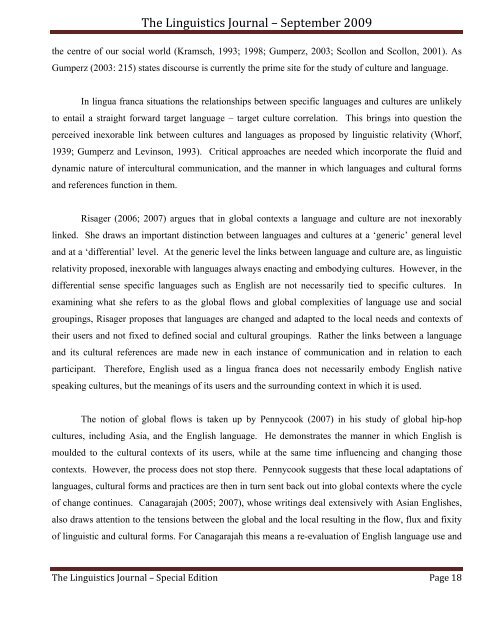The Linguistics Journal September 2009 Special Edition Language
The Linguistics Journal September 2009 Special Edition Language
The Linguistics Journal September 2009 Special Edition Language
Create successful ePaper yourself
Turn your PDF publications into a flip-book with our unique Google optimized e-Paper software.
<strong>The</strong> <strong>Linguistics</strong> <strong>Journal</strong> – <strong>September</strong> <strong>2009</strong><br />
the centre of our social world (Kramsch, 1993; 1998; Gumperz, 2003; Scollon and Scollon, 2001). As<br />
Gumperz (2003: 215) states discourse is currently the prime site for the study of culture and language.<br />
In lingua franca situations the relationships between specific languages and cultures are unlikely<br />
to entail a straight forward target language – target culture correlation. This brings into question the<br />
perceived inexorable link between cultures and languages as proposed by linguistic relativity (Whorf,<br />
1939; Gumperz and Levinson, 1993). Critical approaches are needed which incorporate the fluid and<br />
dynamic nature of intercultural communication, and the manner in which languages and cultural forms<br />
and references function in them.<br />
Risager (2006; 2007) argues that in global contexts a language and culture are not inexorably<br />
linked. She draws an important distinction between languages and cultures at a ‘generic’ general level<br />
and at a ‘differential’ level. At the generic level the links between language and culture are, as linguistic<br />
relativity proposed, inexorable with languages always enacting and embodying cultures. However, in the<br />
differential sense specific languages such as English are not necessarily tied to specific cultures. In<br />
examining what she refers to as the global flows and global complexities of language use and social<br />
groupings, Risager proposes that languages are changed and adapted to the local needs and contexts of<br />
their users and not fixed to defined social and cultural groupings. Rather the links between a language<br />
and its cultural references are made new in each instance of communication and in relation to each<br />
participant. <strong>The</strong>refore, English used as a lingua franca does not necessarily embody English native<br />
speaking cultures, but the meanings of its users and the surrounding context in which it is used.<br />
<strong>The</strong> notion of global flows is taken up by Pennycook (2007) in his study of global hip-hop<br />
cultures, including Asia, and the English language. He demonstrates the manner in which English is<br />
moulded to the cultural contexts of its users, while at the same time influencing and changing those<br />
contexts. However, the process does not stop there. Pennycook suggests that these local adaptations of<br />
languages, cultural forms and practices are then in turn sent back out into global contexts where the cycle<br />
of change continues. Canagarajah (2005; 2007), whose writings deal extensively with Asian Englishes,<br />
also draws attention to the tensions between the global and the local resulting in the flow, flux and fixity<br />
of linguistic and cultural forms. For Canagarajah this means a re-evaluation of English language use and<br />
<strong>The</strong> <strong>Linguistics</strong> <strong>Journal</strong> – <strong>Special</strong> <strong>Edition</strong> Page 18


